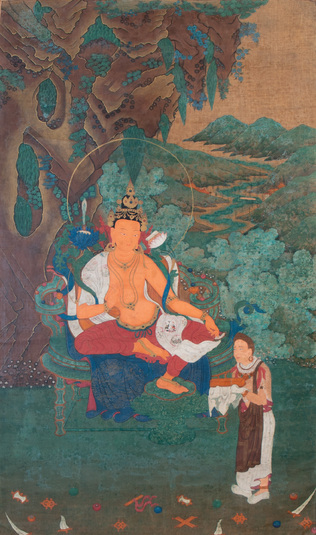
Item: Manjushri (Bodhisattva & Buddhist Deity) - Bodhisattva
| Origin Location | Tibet |
|---|---|
| Date Range | 1700 - 1799 |
| Lineages | Buddhist |
| Material | Ground Mineral Pigment on Cotton |
| Collection | Anna Maria Rossi & Fabio Rossi |
Classification: Deity
Appearance: Peaceful
Gender: Male
Manjushri (Tibetan: Jampalyang, Jampaiyang (rje btsun 'jam pa'i dbyangs) is a popular Buddhist figure commonly represented in art. He first arises from the Mahayana Sutra literature of Northern Buddhism where he is regarded as a bodhisattva - the bodhisattva of wisdom. In artistic depictions these forms are non-iconic in appearance which means that the iconography is not fixed. Manjushri will still have one face and two arms. His typical emblem is a Prajnaparamita sutra book held in the left hand or supported by a flower blossom. A sword is often held in the right hand. In art he is typically depicted in a relaxed posture, in front of a temple or portrayed in narrative settings.
This single composition of Manjushri belongs to the group of the Eight Great Bodhisattvas and a nine painting set. Typically the central painting of the set would be either Shakyamuni or Amitabha Buddha. The painting style appears to be Eastern Tibetan from the Lhatog region south of Chamdo and strongly associated with Khampa Gar, a stronghold of the Drugpa Kagyu tradition of Tibetan Buddhism. (See other examples of paintings belonging to this composition style).
Eight Great Bodhisattva: Akashagarbha Avalokiteshvara Kshitigarbha Maitreya Manjushri Nivarana-vishkhambhin Samantabhadra Vajrapani
Manjushri has an orange complexion, with one face and two arms, a figure in Peaceful Appearance. The proper right hand holds the stem of a blue utpala flower supporting an upright sword. The left hand, extended across the knee, holds a stem of a white flower blossoming at the left ear supporting a folio text. His upper robe is a white patterned material. The lower robe is red. A green and blue ribbon-like scarf hovers about the shoulders and trails to the sides. The head and body are adorned with a variety of jewelry. Seated in a relaxed manner atop a blue dragon patterned cloth, Manjushri sits in a relaxed manner with the left leg pendant, the foot resting on a short green flower shaped stool. The throne is whimsical with curved shapes, unusual structures and adorned with multi-coloured wish-fulfilling jewels.
In some Tibetan traditions there The 'Thirteen Adornments of the Peaceful Deity.' They are the 'Five Silken Garments' and the 'Eight Jewel Ornaments.'
The Five Silken Garments are: - scarf - pendants for the crown - upper garment - lower garment - Sleeves for dancing
The Eight Jewel Ornaments are:: - crown - earrings - necklace, short - necklace, medium - necklace, long - shoulder ornament - bracelets - anklets
Manjushri wears most of these garments and ornaments which are described in the technical manuals written for religious rituals and meditation practice. The artist however has a fair amount of freedom and can re-interpret the garments and ornaments depending on the subject of a painting. In this case we have a non-iconic depiction of Manjushri which means that he is being portrayed as a student of the Buddhas as described in the sutra literature of Mahayana Buddhism.
Tantric images of Manjushri are very technical and precise. They are iconic and unchanging for the most part, static and formalized. Mahayana depictions are fluid and dynamic and generally only conform to cultural and artistic convention and not to technical iconographic Tantric literature.
With these kinds of depictions which fall under the category of Mahayana Buddhism there are no strict iconographic descriptions for the bodhisattvas. They can sit in any posture that the artist chooses. They can carry their attributes in any manner or even have them resting on a table at the side, or held in the hand of an attendant figure. The colours of the garments will be influenced by the colour chosen for the figures face, body and arms.
Jeff Watt 2-2017
Painting Set: Eight Great Bodhisattvas (Kham Group 1)
Buddhist Deity: Manjushri Main Page
Collection of Anna Maria Rossi & Fabio Rossi


